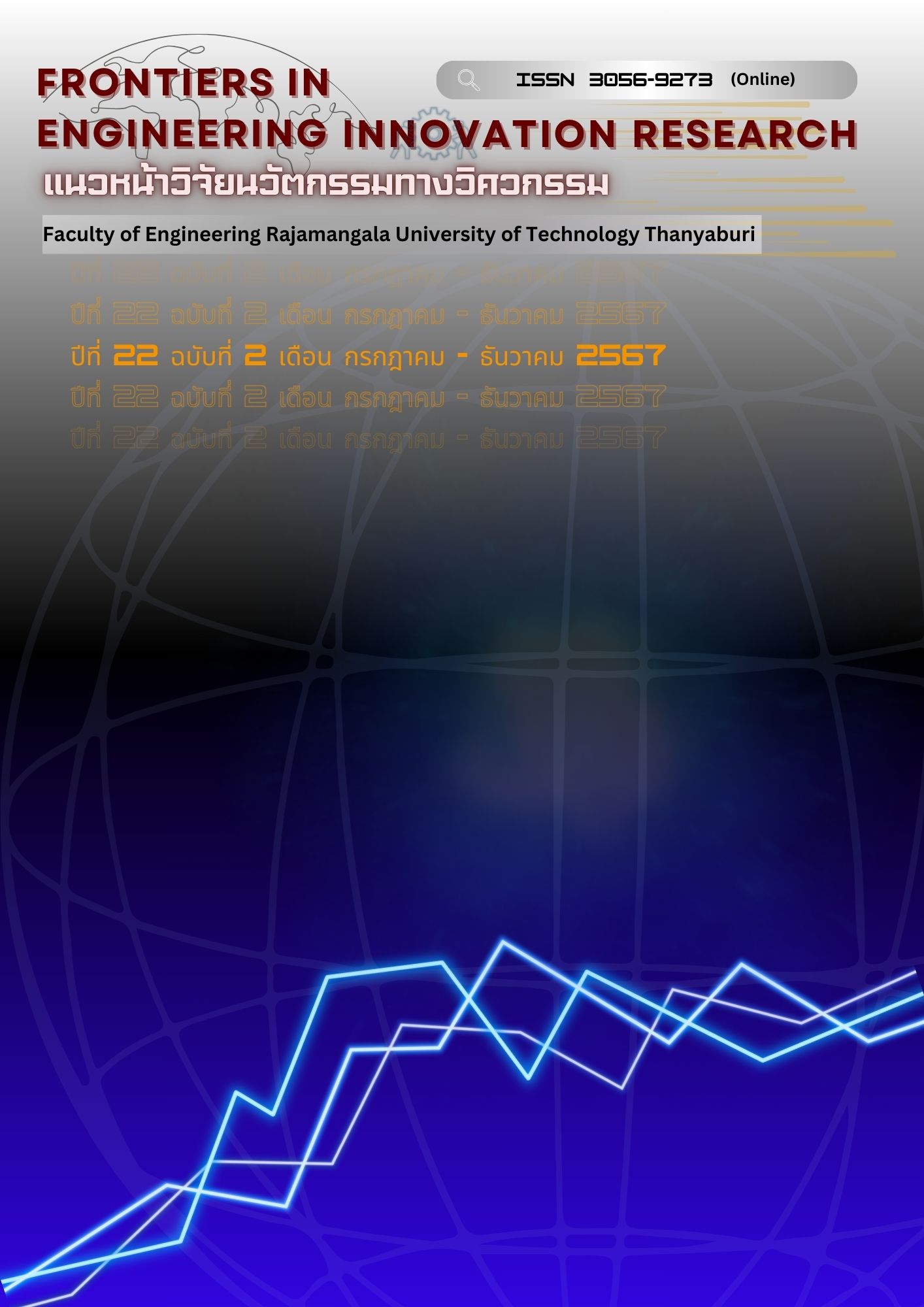Development of bio-composite material from polylactic acid blended with thermoplastic from sago starch and reinforced with pineapple leaf fiber
Main Article Content
Abstract
This study analyzes the effects of pineapple leaf fiber (PALF) content on the physical, mechanical, and thermal properties of PLA/TPS and PLA/TPSW composites and material cost. Thermoplastic starch (TPS) is derived from sago starch with glycerol as a plasticizer, while TPSW incorporates water with glycerol. The proportions of TPS and TPSW were set at 0%, 5%, 10%, 15%, and 20% by weight, combined with PLA and PALF at 0%, 2%, 4%, 6%, 8%, and 10% by weight. Results show that PLA/TPS exhibits higher melt flow index and density, indicating better flowability and suitable density. Additionally, PLA/TPS has slightly higher water absorption due to the cross-linked structure of TPSW, while retrogradation reduces water absorption due to increased rigidity and brittleness. The mechanical properties of PLA/TPS are higher with increased PALF content. This significantly enhances resistance to bending and impact due to improved stress distribution, while PLA/TPSW shows minor improvements because of uneven fiber distribution and recrystallization. Increased PALF content reduces tensile strength in both composites. This reduction is more pronounced in PLA/TPSW, as SEM analysis indicates poor adhesion and fiber distribution leading to fiber pull-out. In thermal properties, adding 10% PALF to PLA/TPSW enhances crystallization temperature (Tc) and crystallinity percentage, with lesser effects observed in PLA/TPS. Finally, PLA/TPS demonstrates better physical and mechanical properties, especially with 10% PALF and exhibits the lowest material costs, PLA/TPS composite at PALF (10%) can be molded via injection machine into cups, making it suitable for commercial development with a maximum service temperature not exceeding 50 degrees Celsius.
Article Details

This work is licensed under a Creative Commons Attribution-NonCommercial-NoDerivatives 4.0 International License.
The manuscript, information, content, picture and so forth which were published on Frontiers in engineering innovation research has been a copyright of this journal only. There is not allow anyone or any organize to duplicate all content or some document for unethical publication.
References
Chu J, Yin X, He M, Ouyang W, Lin C, Liu X. Substance flow analysis and environmental release of antimony in the life cycle of polyethylene terephthalate products. Journal of Cleaner Production. 2021;291:125252.
Wang Y, Hu T, Zhang W, Lin J, Wang Z, Lyu S, Tong H. Biodegradation of polylactic acid by a mesophilic bacteria Bacillus safensis. Chemosphere. 2023;318:137991.
Yu J, Xu S, Liu B, Wang H, Qiao F, Ren X, Wei Q. PLA bioplastic production: From monomer to the polymer. European Polymer Journal. 2023;193:112076.
Mistry AN, Kachenchart B, Wongthanaroj A, Somwangthanaroj A, Luepromchai E. Rapid biodegradation of high molecular weight semi-crystalline polylactic acid at ambient temperature via enzymatic and alkaline hydrolysis by a defined bacterial consortium. Polymer Degradation and Stability Journal. 2022;202:110051.
Qin Q, Yang Y, Yang C, Zhang L, Yin H, Yu F, Ma J. Degradation and adsorption behavior of biodegradable plastic PLA under conventional weathering conditions. Sci Total Environ. 2022;842:156775.
Pulgarin HLC, Caicedo C, López EF. Effect of surfactant content on rheological, thermal, morphological and surface properties of thermoplastic starch (TPS) and polylactic acid (PLA) blends. Heliyon. 2022;8(10).
Sayeed MMM, Sayem ASM, Haider J, Akter S, Habib MM, Rahman H, Shahinur S. Assessing mechanical properties of jute, kenaf, and pineapple leaf fiber-reinforced polypropylene composites: Experiment and modelling. Polymers. 2023;15:830.
Suteja J, Firmanto H, Soesanti A, Christian C. Properties investigation of 3D printed continuous pineapple leaf fiber-reinforced PLA composite. Journal of Thermoplastic Composite Materials. 2022;35(11):2052-61.
Chotiprayon P, Chaisawad B, Yoksan R. Thermoplastic cassava starch/poly (lactic acid) blend reinforced with coir fibres. International journal of biological macromolecules. 2020;156:960-8.
Srithep Y, Hongkhaum N, Takhot P. Characterization of bioplastics poly (lactic acid) blended with thermoplastic starch. RMUTP Research Journal. 2020;14(2):98-109
Kongsong P, Hokking S, Wiwasuk A, Masae M. The mechanical properties of thermoplastic starch/poly (lactic acid) blends filled with durian peel ash. Rajamangala University of Technology Srivijaya Research Journal. 2021;13(2):357-68. (in Thai)
Manshor M, Anuar H, Aimi MN, Fitrie MA, Nazri WW, Sapuan S, et al. Mechanical, thermal and morphological properties of durian skin fibre reinforced PLA biocomposites. Materials & Design. 2014;59:279-86.


